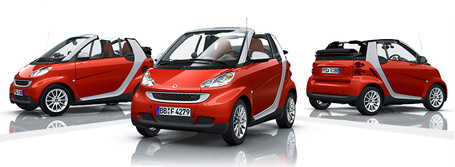The Smart car started its life in the early 90's when Swiss watchmaker, Swatch wanted to create a vehicle that is easy to park and short enough to allow "nose-in" parking. Fuel efficiency was also high on its agenda, with plans to include a hybrid engine. The name smart, an acronym for Swatch Mercedes ART was formed in 1994 and production facilities were established in Smartville, Hambach in France.

The first Smart cars were available to the masses in 1999 with a length of 2.5 metres and an innovative Tridion safety cell. The flared wheel arches were created to enhance the stability of the smart city-coupe as memories of the Mercedes A-Class's failed Elk test in 1997 were still lingering. Despite keen interest worldwide, most of Europe and Australia were the only countries where the Smart had official dealerships. Other Smart models came along, the Smart roadster and coupe and the Smart ForFour. All had since gone out of production as parent Daimler reviewed the weak business plan back in 2004.
Hence, today only one model remains in the Smart range, the Smart Fortwo. A white CDI cabrio was handed to us from Daimler Singapore. This is part of a fleet of Smart cars brought into Singapore to study alternative energies. This second generation Smart car may carry evolutionary looks from its predecessor, but upon close inspection, there is an enhanced cab-forward design for better interior packaging and a more road planted stance with the increase in length and reduced flare wheel arches. If Apple makes a micro city car, this will be it. The Smart Fortwo feels almost like a timeless fashion statement with such a charming shape.
Powered by a 0.8 litre 3-cylinder diesel engine with a tiny turbo-charger, mastering only 45 horsepower, which is fine given the low kerb weight of 800kg. Patience is required here as the century dash takes 19.8 secs. Which is not a bad trade off considering this sub-zero cool car is capable of 3.0 litres per 100 km. With a world beating carbon emission rate of 88 g/km, it makes a Toyota Prius feels like a Hummer, and an uncool one as well.
Jatropha-based bio-diesel powers the Fortwo here. This is a project based in Gujarat, India where the poisonous seeds which are rich in oil are used as feedstock for the Jatropha biofuel. At the same time, the project was based on a barren land to curb soil erosion, soil deterioration and poverty of farmers in the area. Now, that is being green for you.
Alarmingly, the Smart Fortwo is actually fun to drive. Despite the pronounced body roll from the height and lack of perceived stability from its short length, I enjoyed punting the Fortwo about as the steering is direct and there was reasonable levels of ride comfort. Avoid being brave and stick to sensible speeds during quick cornerings and you will be fine.
The party piece of the Cabrio would be the removable roof panels once the canvas roof is down. Thoughtful designers has created two tight fitting slots in the tailgate for the roof bars to be stored; no need for gym bunnies here for this task as they are relatively light and easy to operate. As a strict two seater, there is plenty of interior room; managing two muscle queens or even a pair of cuddly bears will not be too much of a problem. The sci-fi theme of the exterior styling carries over into the interior with futuristic but logical dials. The Smart Fortwo is a thoroughly cohesive design, impressive for a company with less than a decade of experience in car manufacturing.
From New York to Paris, from Rome to Tokyo, Smart cars enjoy a cult status. In these traffic dense cities, such diminutive vehicles just make so much sense. The ultra modern styling simply does not look out of place in under the urban city lights of Singapore. Driving the Smart Fortwo about town warrants as much attention as a Ferrari F430, as there is nothing much else like the Smart Fortwo on our roads.
Reality bites. A Smart Fortwo will set you back at the thick end of S$90,000. In addition, Singapore's LTA still does not recognise diesel's improved fuel efficiency and green credentials; hence the Fortwo CDI would attract more road taxes per annum than most cooking Corolla Altises on our roads. Hence Daimler has decided to put off plans to bring Smart into Singapore indefinitely although it is now available in China from 160,000RMB (S$34,000).
| Smart Fortwo CDI Cabrio | |
| Engine | 799cc, 3-Cylinder, Diesel (Rear-mounted) |
| Transmission | 5-speed Automated Manual Transmission, Rear Wheel Drive |
| Max. Power | 44 bhp@3800rpm |
| Max. Torque | 110nm@2000-2500rpm |
| 0-100 km/h | 19.8 secs |
| Top speed | 135 km/h |
| Fuel Economy | 3.0 L per 100km (combined cycle) |
| CO2 Emissions | 88 g/km |
| Dimensions (L x W x H) / Weight | 2,695x1,559x1,542 / 800kg |
| Price with COE* | Not Available in Singapore |
*Prices quoted are indicative of prices in Singapore. Please contact your local distributor for prices in your country.

